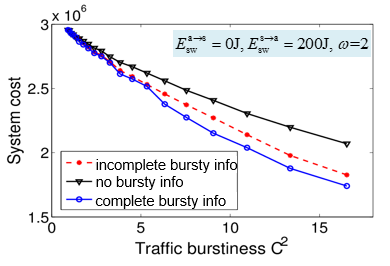Wait-and-See: Optimal Sleeping Policy for Servers with Bursty Traffic
Optimal Server Sleeping Control with Bursty Traffic
Putting servers under low utilization to sleep mode is one of the most effective approaches to reduce the energy consumption in cellular systems, data centers, etc. Meanwhile, traffic demands to the servers are generally of bursty nature, which normally deteriorate the system performance if servers never sleep. A fundamental question then arises: can bursty traffic bring benefits if taking server sleeping control and, if yes, how to control the sleep?
TESLA-based Wait-and-See Structure
1. Single Server Case[1-2]

For a single server queue with renewal bursty traffic (modeled by Interrupted Bernoulli Process), we formulate the problem as a POMDP (partially observable Markov decision process) and show that it can be solved by observing the time elapsed since the last arrival (TESLA). Key factors including switch-over energy consumption as well as delay performance are considered. The optimal sleeping policy is shown to be a wait-and-see (W/S) two-threshold  policy, where the W/S periods are based on the TESLA value. Numerical results show that, surprisingly, traffic burstiness can help to enhance the system performance in terms of weighted sum of energy-consumption and queueing delay. In addition, the higher the burstiness, the larger the performance gain. The more information about the bursty arrivals, the better.
policy, where the W/S periods are based on the TESLA value. Numerical results show that, surprisingly, traffic burstiness can help to enhance the system performance in terms of weighted sum of energy-consumption and queueing delay. In addition, the higher the burstiness, the larger the performance gain. The more information about the bursty arrivals, the better.
2. Multiple Servers Case[3]

For a multi-server queue with non-renewal bursty traffic (modeled by Markov Modulated Poisson Process), based on the similar approach as in the single server case, we show that the optimal operation is again a queue-threshold-based policy. Specifically, the number of active (or sleeping) servers is hysteretic and monotone and should be dynamically adjusted based on the queue length as well as the bursty arrival phases. The exact thresholds are given by numerically solving the Markov decision process. In conclusion, for the optimal turn-on thresholds, it is almost linear with the number of active servers no matter the arrival process is ON or in OFF phases. It is also shown that the optimal sleeping mechanism with multiple servers exhibits a slow activation, rapid and late (only when the queue length is quite small) shutdown feature.
[1] B. Leng, B. Krishnamachari, X. Guo and Z. Niu, ‘‘Optimal Operation of a Green Server with Bursty Traffic,” IEEE GLOBECOM, Washington D.C., Dec. 2016.
[2] B. Leng, X. Guo, X. Zheng, B. Krishnamachari and Z. Niu, "A Wait-and-See Two-Threshold Optimal Sleeping Policy for a Single Server With Bursty Traffic," IEEE Trans. Green Commun. Netw., 1(4): 528-540, Dec. 2017.
[3] Z. Jiang, B. Krishnamachari, S. Zhou and Z. Niu, "Optimal Sleeping Mechanism for Multiple Servers with MMPP-Based Bursty Traffic Arrival,“ IEEE Wireless Commun. Lett., 2018 (in press).
